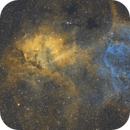Interested in learning from folk's comments on this topic. Currently I use an Astronomik 6 nm OIII filter. How many of the problems below are ameliorated by using a 3nm filter and by how much?
For me - some of the main issues with OIII imaging are..
1) Much more prone to light pollution than HA - I tend to reserve 6 nm OIII for moonless nights only.
2) For many objects (type II nebulae especially) there is a need to accumulate a lot of OIII data to get reasonable levels of SNR that do not add too much noise to the final combined NB image
3) Even after 2) the OIII signal normally ends up being stretched more than the HA.
4) The stars end up bigger than in the HA image - and after star removal (e.g. using PI starnet) tend to leave behind more and larger artifacts in the starless image (including oversized Newtonian spikes - hard to get diminish prior to Starnet removal using starmasks and morphology tools etc)
So when you put together the starless NB image there are artifactual areas of blue corresponding to the OIII star ghosts and spikes.
At the moment I try to ameliorate these problems by 1) very careful use of clone stamp tool to smooth out obvious artifacts- really don't like doing that ! and 2) replacing all the stars with RGB stars from an OSC image - and then minimising the size of stars and improving nebula detail / SNR by replacing the luminance of the final image with the HA luminance (only in those cases where HA is so dominant that it is reasonable to do so).
Back to the question though - to what extent would a 3 nm rather than a 6 nm filter ameliorate the above problems
Tim
For me - some of the main issues with OIII imaging are..
1) Much more prone to light pollution than HA - I tend to reserve 6 nm OIII for moonless nights only.
2) For many objects (type II nebulae especially) there is a need to accumulate a lot of OIII data to get reasonable levels of SNR that do not add too much noise to the final combined NB image
3) Even after 2) the OIII signal normally ends up being stretched more than the HA.
4) The stars end up bigger than in the HA image - and after star removal (e.g. using PI starnet) tend to leave behind more and larger artifacts in the starless image (including oversized Newtonian spikes - hard to get diminish prior to Starnet removal using starmasks and morphology tools etc)
So when you put together the starless NB image there are artifactual areas of blue corresponding to the OIII star ghosts and spikes.
At the moment I try to ameliorate these problems by 1) very careful use of clone stamp tool to smooth out obvious artifacts- really don't like doing that ! and 2) replacing all the stars with RGB stars from an OSC image - and then minimising the size of stars and improving nebula detail / SNR by replacing the luminance of the final image with the HA luminance (only in those cases where HA is so dominant that it is reasonable to do so).
Back to the question though - to what extent would a 3 nm rather than a 6 nm filter ameliorate the above problems
Tim





